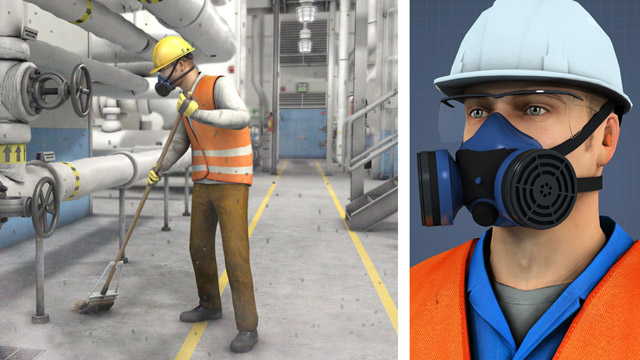




Air-Purifying Respirators
Air-purifying respirators are one of two major classes of respirators (the other being air-supplying respirators). This course explains the basics of air-purifying respirators, including the three major types: single-use disposable respirators, also called dust masks; air-purifying respirators with a flexible, elastomeric quarter-mask, half-mask, or full-mask facepiece; and powered air-purifying respirators, or PAPRs. Topics covered include uses, inspection, maintenance, cleaning, and storage of air-purifying respirators.
Request a demoCourse Details
Learning Objectives
By the end of this course, you will be able to:
- Differentiate between an air-purifying respirator and an air-supplying respirator
- List situations in which air-purifying respirators are commonly used
- Recall three types of air-purifying respirators and some of their characteristics
- Explain what particulate filters, cartridges, and canisters are used for and the purpose of their lettering, numbering, and color-coding systems
- Describe general requirements for medical evaluations, fit tests, seal checks, inspection, maintenance, cleaning, and storage of air-purifying respirators
Specs
| Course Level | Intermediate |
| Languages | English |
| Compatibility | Audio, Video |
| Based on: | OSHA 19101.134 |
Key Questions
What is an air-purifying respirator?
A respirator that filters out, or removes, contaminants from the surrounding air before a person breathes that air.
What are the three basic types of air-purifying respirators?
Single-use, disposable respirators, also commonly called dust masks; air-purifying respirators with a tight-fitting, elastomeric facepiece with a quarter-mask, half-mask, or full-mask design; and powered air-purifying respirators, also called PAPRs.
What’s a primary difference between air-purifying and air-supplying respirators?
In general terms, air-purifying respirators may be more convenient and easier to walk around with, but they’re generally designed to protect against less hazardous environments and they offer no protection in atmospheres that are oxygen deficient.
What should one know before using an air-purifying respirator at work?
The most important thing to know is how to select the respirator to provide proper protection against the hazard (or hazards) in the work atmosphere. In addition, it’s important to know all procedures and requirements for respirator selection, medical evaluation, fit testing, inspection, donning, cleaning, maintenance, and storage.
What are the filters and cartridges in air-purifying respirators used for?
Filters are used to remove particles from the air. The cartridges are used to remove chemicals from the air.
What are the different types of filters?
NIOSH-approved filters are identified with a letter (either N, R, or P) and a number (either 95, 99, or 100). “N” means the filter is not resistant to oil; “R” means the filter is somewhat resistant to oil; and “P” means the filter is strongly resistant to oil, or oil proof. “95” means the filter removes at least 95% of particles; “99” means the filter removes at least 99% of particles; and “100” means the filter removes at least 99.9% of particles.
What are the different types of cartridges?
Cartridges are identified with different colors. Each different color means that the cartridge provides protection against a different, specific gas (but does not provide protection against other gases).
Sample Video Transcript
Tight-fitting, elastomeric respirators come in three sizes: full mask, half mask, and quarter mask. A full mask air purifying respirator covers the entire face. This provides the most protection out of these three respirators because it creates a better seal against the face and also because it protects the eyes and face from airborne irritants or splashed materials. A half mask air purifying respirator covers the nose, mouth and chin. A quarter mask air purifying respirator covers the nose and mouth. Always choose the size of the mask to match the hazards where you’ll be working.
Additional Resources
- Occupational Safety & Health Administration (OSHA) – www.osha.gov
- OSHA Health Topics – https://www.osha.gov/SLTC/respiratoryprotection/index.html
- OSHA InfoSheet – https://www.osha.gov/Publications/OSHA3789info.pdf
- OSHA Publications – https://www.osha.gov/Publications/3384small-entity-for-respiratory-protection-standard-rev.pdf
- The National Institute for Occupational Safety and Health (NIOSH) www.cdc.niosh.gov
- NIOSH Topics – http://www.cdc.gov/niosh/topics/respirators/default.html
- American National Standard of Safety Engineers (ASSE) – www.asse.org
- ASSE Standards – http://www.asse.org/ansi/asse-z88-2-2015-american-national-standard-practices-for-respiratory-protection/
Course Applies To
Demos + Pricing
Learn more about our courses, get pricing, and see our platform.











